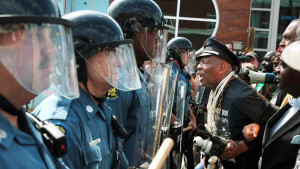The Sunday Times: America must mend its marriage before thoughts turn to divorce
A quick way of assessing the emotional dysfunction of a family is seeing how often its members resort to “blamestorming”. The term (an American invention) refers to meetings at which everyone complains while offloading all responsibility on to someone else. The US is in the middle of a giant blamestorm right now over race, crime and policing.
Depending on which side you’re on, the police are either wilfully murdering black males or are the victims of social persecution. Meanwhile, after reaching historic lows, the crime rate is increasing again: murders are up 19% in Chicago, 33% in New Orleans, 56% in Baltimore and 60% in St Louis over the past year.
Some experts say the two issues are linked, calling the phenomenon the “Ferguson effect”, after the uproar in Ferguson, Missouri, following the fatal police shooting last year of an African-American man named Michael Brown.
Put baldly, the idea behind the “Ferguson effect” is that the Black Lives Matter movement against police brutality (combined with social media, national hysteria and liberal bias in the press) is actually costing lives.
The term was coined in February by Sam Dotson, the St Louis chief of police, who declared that his officers now feared “that if they went out to do their job and they were forced to use force, that somehow they would be the catalyst for the next round of civil unrest”.
Last week Loretta Lynch, the US attorney-general, insisted there was absolutely no data to support any such “effect”. The only problem is that James Comey, the director of the FBI, is telling the media the exact opposite: “I do have a strong sense that some part of the explanation [for the higher statistics] is a chill wind blowing through American law enforcement over the last year.”
So what’s really going on here? As with any unhappy family, emotions have become so entangled that normality has been sacrificed for psychodrama.
But what makes this worse — apart from the toxic legacy of slavery and residual racism — is America’s tortuous history with guns, crime and a murder rate that has always been the highest of any democracy in the world.
Europeans have regarded America as a violent country since its infancy. In the 1830s Alexis de Tocqueville wrote: “At the slightest quarrel, a knife or pistol comes to hand . . . it is a semi-barbarous state of society.” New York in the 1850s had a murder rate 10 times higher than that of London.
Yet American authorities were spending more money on prisons and law enforcement than almost any other country. They carried on spending, murders carried on rising and all the while the homicide rate in 19th-century Europe kept on dropping.
Then in the 20th century came a series of unexpected crime swings, the greatest being a spike that began in the 1960s. In 1963, the year President John F Kennedy was assassinated, the murder rate was 4.6 per 100,000 people.
By 1980 it had reached 10.1. The sense of helplessness in the face of random violence was summed up by the famous 1990s headline on the satirical website The Onion: “Every New Yorker Found Murdered”.
Attempts to account for the postwar crime wave have resulted in theories about lead poisoning being responsible for making Americans violent and stupid, that the Vietnam War turned them against authority, that the baby boom generation produced too many feckless young men or even that rising divorce rates wrecked social stability. The list goes on. But there’s no universally accepted explanation, which is partly why sociologists were taken by surprise when the murder rate suddenly went into reverse in the mid-1990s.
Today the national homicide rate is 4.5 per 100,000, lower than it was in 1963. Los Angeles has seen a drop of 90% since its all-time high in 1992. Initially, people put it down to more prison sentences. Yet exhaustive studies have shown that mass incarceration — there are 2.3m people behind bars in America — can account for only about 15%-20% of the fall.
Other theories talk about rising economic productivity, access to abortion, the decline of crack cocaine and the implementation of the “broken windows” method of community policing, though all suffer from an inability to solve the riddle of counter-examples.
All this uncertainty about the reasons behind the greatest social change of the past 50 years makes Americans terrified of a return to the bad old days. Understandably they fear what they cannot control and this makes them irrational, angry and selective in what they see.
It’s true that a few police departments have been getting the “blue flu”. Late last year, for example, the New York police department protested against the ambush killing of two officers with an undeclared slowdown. But that’s different from saying malevolent constituencies are causing the police to abandon the streets to criminals.
The crime rate had already started rising in St Louis when Brown was killed; and policing in Baltimore was already down because of a contract dispute before the rioting that accompanied the death in custody of Freddie Gray in April.
This year’s blip could be just a normal fluctuation within a five-year cycle. The attorney-general is right: there is no hard evidence of a “Ferguson effect”. What she should be talking about instead is the “Ferguson result”.
The real threat to society is not the possibility of more crime but the actual breakdown in trust between black and white America. The lesson of Ferguson and Baltimore is that irrespective of how some police departments feel today, a great many black communities have felt under siege for a while.
That is a fact, not a theory, and it urgently needs addressing before rasher voices start calling for a divorce.

